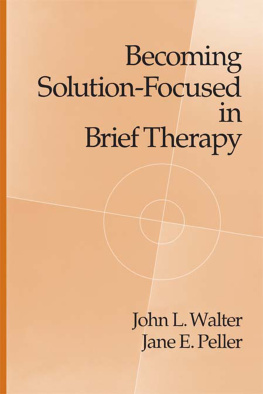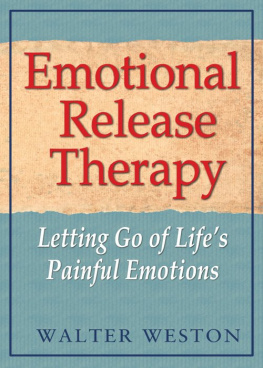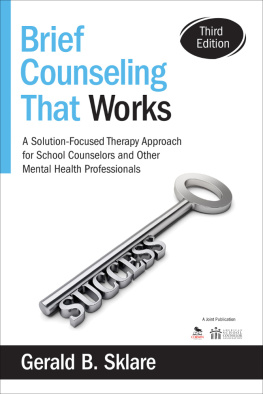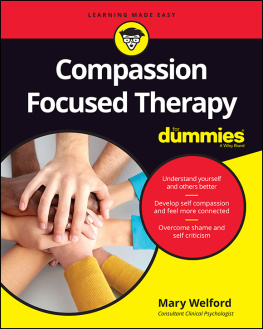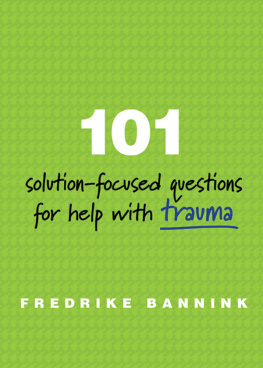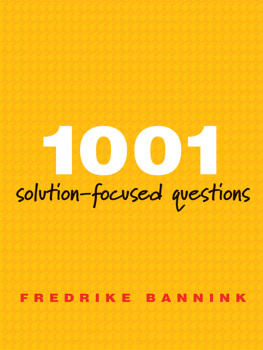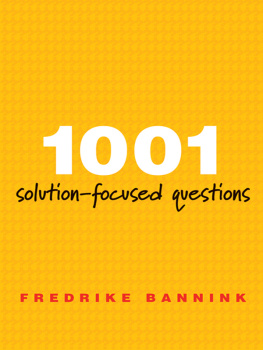Walter John L. - Becoming Solution-Focused In Brief Therapy
Here you can read online Walter John L. - Becoming Solution-Focused In Brief Therapy full text of the book (entire story) in english for free. Download pdf and epub, get meaning, cover and reviews about this ebook. publisher: Taylor and Francis, genre: Home and family. Description of the work, (preface) as well as reviews are available. Best literature library LitArk.com created for fans of good reading and offers a wide selection of genres:
Romance novel
Science fiction
Adventure
Detective
Science
History
Home and family
Prose
Art
Politics
Computer
Non-fiction
Religion
Business
Children
Humor
Choose a favorite category and find really read worthwhile books. Enjoy immersion in the world of imagination, feel the emotions of the characters or learn something new for yourself, make an fascinating discovery.
- Book:Becoming Solution-Focused In Brief Therapy
- Author:
- Publisher:Taylor and Francis
- Genre:
- Rating:4 / 5
- Favourites:Add to favourites
- Your mark:
- 80
- 1
- 2
- 3
- 4
- 5
Becoming Solution-Focused In Brief Therapy: summary, description and annotation
We offer to read an annotation, description, summary or preface (depends on what the author of the book "Becoming Solution-Focused In Brief Therapy" wrote himself). If you haven't found the necessary information about the book — write in the comments, we will try to find it.
Becoming Solution-Focused In Brief Therapy — read online for free the complete book (whole text) full work
Below is the text of the book, divided by pages. System saving the place of the last page read, allows you to conveniently read the book "Becoming Solution-Focused In Brief Therapy" online for free, without having to search again every time where you left off. Put a bookmark, and you can go to the page where you finished reading at any time.
Font size:
Interval:
Bookmark:

SOLUTION-FOCUSED
IN BRIEF THERAPY
SOLUTION-FOCUSED
IN BRIEF THERAPY
Jane E. Peller

Published in 1992 by | Published in Great Britain by |
1992 by Taylor & Francis Group, LLC
Routledge is an imprint of Taylor & Francis Group
Printed in the United States of America on acid-free paper
28 27 26 25 24 23 22 21 20 19
International Standard Book Number-10: 0-87630-653-9 (Hardcover)
International Standard Book Number-13: 978-0-87630-653-6 (Hardcover)
Library of Congress catalog number: 91-43491
No part of this book may be reprinted, reproduced, transmitted, or utilized in any form by any electronic, mechanical, or other means, now known or hereafter invented, including photocopying, microfilming, and recording, or in any information storage or retrieval system, without written permission from the publishers.
Trademark Notice: Product or corporate names may be trademarks or registered trademarks, and are used only for identification and explanation without intent to infringe.
Library of Congress Cataloging-in-Publication Data
Catalog record is available from the Library of Congress
 | Visit the Taylor & Francis Web site at and the Routledge Web site at |
T o the memory of Johns mother, Afra Walter, and to our parents, William Walter, Jonesy Wagner, Bert Peller, Victor Wagner, and Suzanne Peller, who in their own ways continually keep us optimistic and on track.
A book is never written by the authors alone. It is always a team effort and the authors just get to have their names on the cover. We want to thank family, friends, trainees, clients, and workshop participants, all of whom have contributed in their own unique ways.
We want to say a special thanks to Insoo Kim Berg and Steve de Shazer. Through our association and friendship with each of them, we have grown tremendously. We feel honored to be the spokespersons for many of their contributions to the development of Brief Therapy that they shared with us.
John wants to thank Insoo for first asking him, Why do you want to be a Brief Therapist? It could be a very upsetting change. Jane wants to thank Steve for reminding her to be simpleminded.
We also want to offer a special thank you to Eve Lipchik, who was the first to suggest that we write a manual. Her support was gentle in each reminder of You can do it.
We want to thank our friends, Jill Freedman and Gene Combs, who having struggled through the writing and publication of their own book, were a constant source of encouragement and helpful hints.
John wants to thank Michael Banks. Through Michaels outsiders curiosity and provoking questions, John sharpened and developed his own thinking about what we do. Michaels enthusiasm for our project was always there.
Jane wants to thank her chairperson at Northeastern Illinois University, Wanda Bracy, for giving her the release time to work on the book. She also wants to thank Wanda for enhancing Janes confidence in being able to take on any project by their mutual suffering through the self-study of their department.
We want to thank all the individuals who read some of the manuscript and offered us much appreciated feedback. We want to thank Bert Peller, who went over the manuscript many times and always managed to sneak in a compliment before making a suggestion. We also want to thank Victor Wagner, Mary Jo Barrett, and Goldie Lansky for offering not only their suggestions, but also their confusion as we struggled to give words to our ideas.
We want to thank du Ree Bryant, Kate Kowalski, and Kevin OConnor whose excitement continued to give us energy. We want to thank Jim Weiss who not only kept us in a frame of humor, but also kept our sometimes resistant computer up and running.
Of course, there is everyone else who simply asked How is it going? and then had the patience to listen.
Our final thanks goes to our editors, Natalie Gilman and Suzi Tucker, whose steady voices on the phone kept us focused during anxious moments.
This is a handbook for becoming solution-focused and for constructing solutions in brief therapy. Throughout the past several years, we have provided training for professionals who want to work briefly. They want to work in a positive way with people, and do not believe that pathologizing is useful. Workshop participants have consistently told us they wanted something more than just a workshop, something more than only an introduction, something useful they could look at between sessions, something they could use to practice with, something that would keep their learning going. The message was clear. This manual, Becoming Solution-Focused in Brief Therapy is our answer to all those requests.
In this manual, we describe how we came to a solution orientation. We describe the positive assumptions that inform our work, and then, in step-by-step fashion, provide a sequence of skill-building chapters.
reviews the historical progression of assumptions that have informed therapy models for the past hundred years. By examining the presuppositions within the major questions that led to model development, we describe several trends. This leads to the presuppositions of the founding question of a solution-focused approach, How do we construct solutions?
lists and explains the 12 assumptions that guide the authors thoughts and actions. In sum, the assumptions reflect the authors positive and future-oriented approach.
and the further direction of the therapeutic conversationis carried throughout the book.
describes our operating metaphor, that of movie-making, with our clients being both the directors and the principal actresses or actors. We assume that our expertise is not in evaluating normality or pathology but in facilitating movie-making processes. We assume that a well-defined goal is critical in order for movie-making to take place and for the therapy conversation to open up differences and possibilities. This chapter makes explicit the six criteria for a well-defined goal and how to make it easy for clients to create their goal within these guidelines.
provides an overview of the pathways of constructing solutions. The all-important distinction of wishes and complaints versus goals and problems is made first. Then the overview is laid out in terms of frames and the accompanying questions:
- The goal frames question is, What is your goal in coming here?
- The exception frames question is, When is it happening somewhat already? or When doesnt the problem happen?
- The hypothetical solution frames question is, If the problem were solved, what would you be doing differently?
helps the reader develop skills in the use of the exceptions questions.
operationalizes even further our positive orientation by detailing how to offer positive feedback and solution-developing tasks.
describes how to keep change going and how to make sure the therapy is brief Suggestions are given for subsequent sessions, spacing sessions, and concluding therapy.
Font size:
Interval:
Bookmark:
Similar books «Becoming Solution-Focused In Brief Therapy»
Look at similar books to Becoming Solution-Focused In Brief Therapy. We have selected literature similar in name and meaning in the hope of providing readers with more options to find new, interesting, not yet read works.
Discussion, reviews of the book Becoming Solution-Focused In Brief Therapy and just readers' own opinions. Leave your comments, write what you think about the work, its meaning or the main characters. Specify what exactly you liked and what you didn't like, and why you think so.

